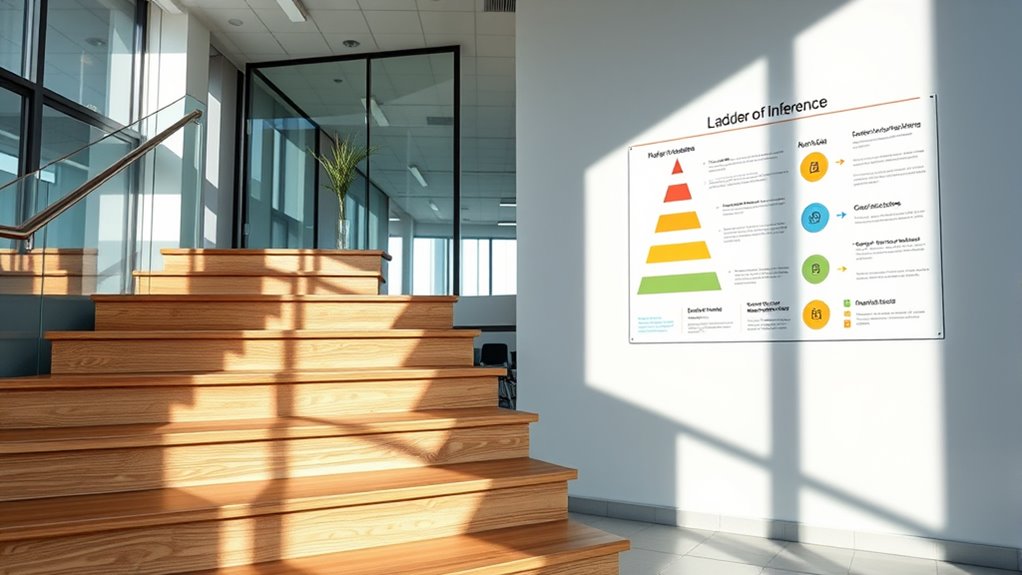The Ladder of Inference shows how you can jump to faulty conclusions by moving quickly from facts to assumptions and beliefs. Your perception filters, shaped by past experiences and biases, influence how you interpret information. To avoid errors, pause and reflect on your thoughts, challenge your assumptions, and recognize biases that may cloud your judgment. Building self-awareness and using deliberate decision steps help you make more rational choices—if you keep exploring, you’ll uncover even more effective strategies.
Key Takeaways
- Recognize that perceptions are filtered through mental shortcuts and biases, which can lead to faulty conclusions if unchecked.
- Use reflection and questioning to challenge assumptions and verify whether beliefs are based on facts or biases.
- Pause and practice mindful decision-making to prevent impulsive judgments influenced by emotional reactions.
- Apply structured evaluation and predictive modeling to analyze options objectively and anticipate potential outcomes.
- Cultivate self-awareness of emotional and cognitive influences to improve judgment and avoid distortions in reasoning.
Understanding the Rungs of the Ladder

Understanding the rungs of the ladder is essential because it reveals how you move from observing facts to making assumptions and conclusions. Your perception filters shape what you notice first, filtering incoming information based on past experiences, beliefs, and biases. These filters act as mental shortcuts, helping your brain process complex data quickly. As you ascend the ladder, you interpret and give meaning to what you see and hear, often without realizing it. Each step narrows your perspective, influenced by your mental shortcuts, which can lead to distorted views. Recognizing these rungs helps you understand how your perceptions are shaped, making you aware of the automatic processes that influence your thinking. This awareness is the first step in avoiding faulty conclusions driven by unexamined assumptions. Understanding cognitive biases can further enhance your ability to identify when your perceptions are being influenced by faulty patterns. Being aware of perception filters can help you identify when your assumptions are skewed by personal biases or incomplete information. Additionally, acknowledging confirmation bias can help you challenge your initial impressions and consider alternative viewpoints. Developing a clear understanding of mental shortcuts can assist in recognizing when these automatic processes are affecting your judgments. Recognizing the influence of selective perception allows you to broaden your awareness of how you may overlook important details.
How Assumptions Shape Our Thinking

Assumptions act as mental shortcuts that heavily influence how you interpret information and make decisions. They often stem from implicit biases, which are unconscious beliefs shaping your perceptions without your awareness. These biases act as cognitive shortcuts, helping your brain process complex information quickly but sometimes leading to flawed conclusions. When you assume things are true without thorough evidence, you rely on these shortcuts, which can distort your understanding of reality. Your assumptions fill in gaps, often based on past experiences or stereotypes, affecting how you see others and interpret situations. Recognizing how assumptions function as cognitive shortcuts is essential for avoiding errors in thinking. By becoming aware of these automatic mental patterns, you can challenge unfounded assumptions and improve your decision-making process. Additionally, understanding water-related experiences can help broaden perspectives and reduce misjudgments by emphasizing shared human interactions with water environments. Developing an awareness of implicit biases is crucial because they often influence assumptions without conscious recognition, further shaping our perceptions and judgments. Being mindful of home furnishings and their influence on comfort and safety can also serve as a reminder to question assumptions about the environments we inhabit. Recognizing the influence of investment strategies, such as those involved in Gold IRA rollovers, can help prevent hasty decisions based on incomplete information. Moreover, considering the impact of AI in everyday tech can shed light on how technological assumptions shape our perceptions of innovation and security.
Recognizing Biases in Our Thought Process

Recognizing biases in your thought process requires you to actively examine the mental shortcuts and automatic judgments that influence your perceptions. Cognitive biases, like confirmation bias or anchoring, can skew how you interpret information without you realizing it. Emotional influences also play a significant role, as feelings such as fear or excitement can distort your reasoning. Being aware of these biases helps you identify when your thinking might be clouded by automatic patterns or emotional reactions. Paying attention to Cognitive biases allows you to question your assumptions and seek a more objective perspective. Developing a mindful approach can further enhance your awareness of these influences, helping you prevent faulty conclusions rooted in subconscious biases, making your decision-making clearer, more balanced, and less prone to error. Incorporating self-awareness techniques can assist in recognizing when biases are affecting your judgments. Additionally, understanding the Ladder of Inference can help you trace how assumptions are formed and challenge them effectively.
Strategies to Pause and Reflect

To effectively manage biases in your thinking, it’s essential to develop strategies that encourage you to pause and reflect before jumping to conclusions. Practicing mindful pauses allows you to slow down and observe your thoughts without immediate judgment. Incorporate reflective questioning to challenge assumptions and clarify reasoning. For example, ask yourself, “What evidence supports this view?” or “Could there be another explanation?” These techniques create space to evaluate your thought process objectively. Consider the following table for quick reference:
| Technique | Purpose | Example Question |
|---|---|---|
| Mindful pauses | Slow down impulsive reactions | “Am I rushing to judgment?” |
| Reflective questioning | Examine assumptions and beliefs | “What’s my evidence?” |
| Taking deep breaths | Reduce emotional reactivity | “How do I feel right now?” |
| Reconsideration | Reassess initial conclusions | “Is this conclusion still valid?” |
Engaging in these reflection techniques can help you develop a more balanced and accurate understanding of your beliefs and perceptions. Recognizing and mitigating cognitive biases further enhances your ability to think critically and objectively. Additionally, becoming aware of thinking patterns can aid in recognizing when you might be influenced by faulty logic. Incorporating these strategies into your routine fosters better decision-making and deeper self-awareness.
Building Awareness for Better Decision-Making

Building awareness is a vital step toward making better decisions, as it helps you understand how your thoughts and emotions influence your choices. Recognizing perception biases allows you to see how your mind filters information, often leading to distorted views. Emotional influences can also skew your judgment, making you react impulsively or cling to assumptions. By becoming more aware of these factors, you gain control over your automatic responses and reduce the risk of faulty conclusions. Pay attention to your gut feelings and question whether your perceptions are based on facts or biases. Developing this awareness encourages you to pause and critically evaluate your thoughts, creating space for more rational, informed decisions. Additionally, understanding predictive modeling can help you anticipate outcomes more accurately, reducing the likelihood of errors in judgment. Cultivating self-awareness about your emotional reactions further enhances your ability to interpret information objectively. Recognizing the importance of decision-making processes can improve your overall judgment in complex situations. Ultimately, increased awareness empowers you to navigate complex situations more effectively.
Frequently Asked Questions
How Can I Prevent My Biases From Influencing My Decisions?
To prevent your biases from influencing your decisions, stay aware of common cognitive biases that lead to decision pitfalls. Challenge your assumptions by questioning why you believe what you do and consider alternative viewpoints. Take your time to gather facts before jumping to conclusions. Practice self-awareness and reflect on past biases that affected your choices. This mindfulness helps you make more balanced, objective decisions, reducing the risk of faulty conclusions.
What Are Common Signs I’M Jumping to Conclusions?
You might notice you’re jumping to conclusions when your thinking relies on cognitive shortcuts and assumption triggers. Signs include making quick judgments without enough evidence, overlooking alternative explanations, or reacting emotionally instead of logically. You may also find yourself filling in gaps with assumptions or ignoring contradictory information. Being aware of these signs helps you pause and evaluate whether your conclusions are based on facts or faulty assumptions.
How Does Emotional Thinking Affect the Ladder of Inference?
Emotional thinking influences how you interpret information through emotional bias, which clouds your judgment. This can lead to cognitive distortion, making you jump to conclusions based on feelings rather than facts. When you let emotions drive your reasoning, you risk skipping steps in the ladder of inference, resulting in faulty conclusions. Recognizing this helps you pause, question your assumptions, and make more balanced, objective decisions.
Can the Ladder of Inference Be Applied in Group Decision-Making?
They say two heads are better than one, but the ladder of inference can definitely be applied in group decision-making. You need to watch for groupthink pitfalls and consensus challenges, as biases and assumptions can shape collective conclusions. By recognizing how individuals’ inferences influence group dynamics, you can foster open dialogue, challenge assumptions, and make more informed, balanced decisions, avoiding faulty conclusions that might arise from unchecked group biases.
What Tools Help in Tracking My Thought Process Effectively?
You can track your thought process effectively with tools like mind mapping and thought journaling. Mind mapping helps you visualize connections between ideas, making it easier to see how your thoughts develop. Thought journaling allows you to record and reflect on your reasoning, helping identify biases or faulty assumptions. These tools promote awareness and clarity, ensuring your decisions are based on thoughtful, well-examined reasoning rather than faulty conclusions.
Conclusion
Imagine climbing a ladder blindfolded—you might think you’re headed straight up, but one misstep can send you crashing down. By understanding the ladder of inference, you gain the sight to see each rung clearly. When you pause and reflect, you prevent faulty assumptions from guiding your steps. With awareness, you become the skilled climber, steering decisions confidently and safely, avoiding the pitfalls of bias and faulty conclusions. Climb wisely, and reach your true potential.









